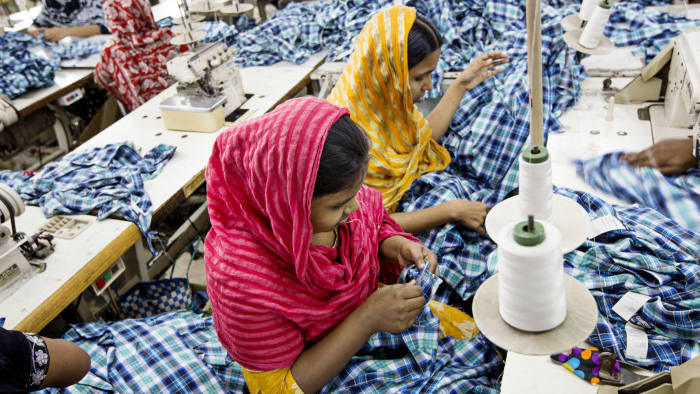Asia's emerging economies are winning US-China trade war
Robin Harding
Financial Times
25 September 2019
Asia’s emerging economies have been the big winners from the US-China trade war and they will gain even more if it escalates, according to the latest outlook from the Manila-based Asian Development Bank.
Exports from developing Asian countries to the US rose by 10 per cent over the previous year in the first half of 2019, even as exports from China fell by 12 per cent. Exports from Vietnam to the US jumped by 33 per cent and from Bangladesh by 13 per cent.
The report shows how the huge trade diversion effects caused by the US-China tariff war are creating winners and losers as they reshape global supply chains, with Bangladesh seizing market share in textiles and Vietnam in electronics.
“Chinese products are encountering tariff measures so exports and production are slowing down.
Naturally, suppliers connected to these Chinese exports are also slowing down,” said Yasuyuki Sawada, chief economist at the ADB, which lends to developing countries in the region.“But at the same time we see this rather positive channel through trade redirection,” he said, at the launch of an update to the bank’s flagship Asian Development Outlook.The more serious trade tensions get, the bigger the trade redirection effect will become.
In a worst-case scenario, with 30 per cent tariffs on all US-China trade plus an extension of the trade war to automobiles, the ADB expects a drag on overall growth in developing Asia of 0.7 per cent over the next few years. Within that, however, Vietnam’s economy would grow by an additional 2.3 per cent, with Malaysia, Thailand, Bangladesh and the Philippines all coming out as winners too.
The analysis does not include the impact of uncertainty over trade hurting investment, which could lead to a worse outcome in reality, Mr Sawada noted.For the region as a whole, the ADB trimmed its growth outlook for 2019 from 5.7 per cent to 5.4 per cent, reflecting the global slowdown, trade tensions and a “sharp contraction” in the global electronics cycle — especially for semiconductors.
The ADB cut its growth forecast for Hong Kong from 2.5 per cent to 0.3 per cent, reflecting the slowdown in global trade as well as political turmoil, and lowered its growth forecast for semiconductor-dependent South Korea from 2.5 per cent to 2.1 per cent.
On the other hand, it raised its growth forecast for Bangladesh from 8 per cent to 8.1 per cent, predicting it will be the fastest-growing economy in the region this year and next.
Mr Sawada said that risks to the region included the US-China trade conflict, the deepening growth malaise in advanced economies as well as a build-up of private debt in some emerging Asian economies. “The corporate sector in China and the household sector in Korea, Thailand and Malaysia have had a rising debt-GDP ratio. I think this is another risk,” he said.
Robin Harding
Financial Times
25 September 2019
Asia’s emerging economies have been the big winners from the US-China trade war and they will gain even more if it escalates, according to the latest outlook from the Manila-based Asian Development Bank.
 |
| Bangladesh has seized market share in textiles © Bloomberg
|
Exports from developing Asian countries to the US rose by 10 per cent over the previous year in the first half of 2019, even as exports from China fell by 12 per cent. Exports from Vietnam to the US jumped by 33 per cent and from Bangladesh by 13 per cent.
The report shows how the huge trade diversion effects caused by the US-China tariff war are creating winners and losers as they reshape global supply chains, with Bangladesh seizing market share in textiles and Vietnam in electronics.
“Chinese products are encountering tariff measures so exports and production are slowing down.
Naturally, suppliers connected to these Chinese exports are also slowing down,” said Yasuyuki Sawada, chief economist at the ADB, which lends to developing countries in the region.“But at the same time we see this rather positive channel through trade redirection,” he said, at the launch of an update to the bank’s flagship Asian Development Outlook.The more serious trade tensions get, the bigger the trade redirection effect will become.
In a worst-case scenario, with 30 per cent tariffs on all US-China trade plus an extension of the trade war to automobiles, the ADB expects a drag on overall growth in developing Asia of 0.7 per cent over the next few years. Within that, however, Vietnam’s economy would grow by an additional 2.3 per cent, with Malaysia, Thailand, Bangladesh and the Philippines all coming out as winners too.
The analysis does not include the impact of uncertainty over trade hurting investment, which could lead to a worse outcome in reality, Mr Sawada noted.For the region as a whole, the ADB trimmed its growth outlook for 2019 from 5.7 per cent to 5.4 per cent, reflecting the global slowdown, trade tensions and a “sharp contraction” in the global electronics cycle — especially for semiconductors.
The ADB cut its growth forecast for Hong Kong from 2.5 per cent to 0.3 per cent, reflecting the slowdown in global trade as well as political turmoil, and lowered its growth forecast for semiconductor-dependent South Korea from 2.5 per cent to 2.1 per cent.
On the other hand, it raised its growth forecast for Bangladesh from 8 per cent to 8.1 per cent, predicting it will be the fastest-growing economy in the region this year and next.
Mr Sawada said that risks to the region included the US-China trade conflict, the deepening growth malaise in advanced economies as well as a build-up of private debt in some emerging Asian economies. “The corporate sector in China and the household sector in Korea, Thailand and Malaysia have had a rising debt-GDP ratio. I think this is another risk,” he said.
No comments:
Post a Comment